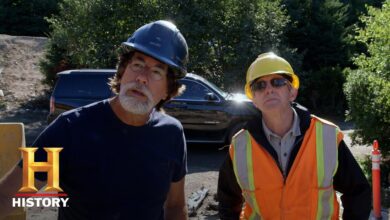Oak Island Mystery Solved After 200 Years of Search!
Oak Island Mystery Solved After 200 Years of Search!

So in 65 January there’s an article about Oak Island, and I turned the first page and I—I was lost.
For centuries, Oak Island has teased treasure hunters with promises of unimaginable riches: pirate gold, the Holy Grail, or perhaps even Templar secrets.
But has the infamous Money Pit finally revealed its secrets in 2025?
Startling discoveries—including hidden pathways in the swamp and a mysterious gemstone found on Lot 5—suggest someone of great wealth visited long before anyone knew the Pit existed.
Could these clues finally unravel the island’s legendary mystery?
Or are we once again chasing shadows?
The truth may be closer than ever, hidden in secrets the island has guarded for centuries.
The Money Pit Origins: The 1795 Discovery
The story starts in 1795, on a quiet tree-covered speck in Nova Scotia’s Mahone Bay.
Three teenagers—Daniel McInnis, John Smith, and Anthony Vaughn—were out exploring when they stumbled upon something odd:
a circular depression under an oak tree, approximately 13 ft wide, with signs someone had been there before.
A pulley system hung above, and freshly cut trees lay nearby.
To these young adventurers, it screamed of hidden treasure.
Driven by dreams of pirate gold, they grabbed shovels and began digging.
At just 2 ft down, they hit flagstones—not natural to the island.
Continuing their excavation, they discovered something even more intriguing at 10 ft:
wooden logs forming a platform, driven into the clay wall.
As they dug deeper, they found another similar platform at 20 ft.
Then another at 30 ft.
Each layer fueled their dreams of discovering pirate gold.
All they found was more dirt.
Word of their discovery spread rapidly throughout the region.
By 1804, the Onslow Company arrived—armed with better tools and bigger ambitions.
They continued digging where the boys had left off, encountering those mysterious wooden platforms at regular intervals: 40 ft, 50 ft, 60 ft down.
Then, at approximately 90 ft, they uncovered something truly strange:
a stone slab with peculiar carvings.
One member of the expedition later claimed it contained an inscription that read:
“40 ft below, two million are buried.”
Before they could verify this tantalizing message, disaster struck.
Water suddenly gushed into the pit, flooding it to a depth of 60 ft.
Despite deploying pumps and attempting to dig bypass tunnels, nothing worked.
The pit seemed designed to drown itself when disturbed—an ingenious trap protecting whatever might lie beneath.
This unexpected flooding mechanism transformed the discovery from a mere hole in the ground to an elaborate puzzle.
Perhaps a trap deliberately constructed to protect something of immense value.
Theories and Evidence
Theories proliferated rapidly:
Captain Kidd’s pirate loot, lost jewels from French kings, even the Holy Grail stashed away by the Knights Templar.
The pit’s sophisticated design—with its regularly spaced log platforms and flooding mechanism—hinted at deliberate human engineering rather than natural formation.
Later discoveries added further intrigue.
Coconut fiber—not native to Nova Scotia—was found in the pit,
suggesting whoever constructed it sailed from far away.
This evidence pointed to deliberate construction by someone with significant resources and engineering knowledge—
not random natural phenomena.
Skeptics, however, had valid counterarguments.
Oak Island sits on glacial terrain with limestone and natural sinkholes.
Could this mysterious pit simply be a geological formation mistaken for human handiwork?
Could the regular platforms be nothing more than debris that collected naturally over time?
In the late 18th century, few treasure hunters concerned themselves with geology.
They saw only the tantalizing possibility of gold.
Regardless of its true nature, the discovery those teenagers made in 1795 sparked a treasure-hunting obsession that has endured for over two centuries.
It has pulled in everyone from local farmers to future presidents—
all united by the belief that something extraordinary lies beneath Oak Island’s surface.
That fateful discovery set the stage for everything that would follow—
a relentless quest for answers that continues with unexpected vigor in 2025.
Centuries of Searching: The Historical Expeditions
That first exploratory dig was merely the warm-up act.
Over the next 200+ years, Oak Island transformed into a veritable treasure-hunting circus,
with each successive expedition chasing glory—
but ultimately leaving behind more questions than answers.
After the Onslow Company abandoned their waterlogged efforts,
the Truro Company arrived on the scene in 1849.
They managed to dig back to a depth of 86 ft,
where they discovered more coconut fiber and charcoal—tantalizing evidence of human activity.
But like their predecessors, they soon encountered the Money Pit’s infamous flooding mechanism.
In a desperate attempt to bypass this obstacle,
they tried digging a side tunnel—
but it collapsed before yielding any treasures.
In 1861, the Oak Island Association launched what was at that time the most sophisticated excavation attempt.
They employed industrial equipment and seemed poised for a breakthrough—
when disaster struck.
A pump exploded, killing a worker.
This tragedy marked the first death associated with the Oak Island hunt,
giving rise to rumors of a curse:
Seven people must die before the treasure reveals itself.
Five more would follow in the decades to come,
adding a macabre dimension to the island’s allure.
The Money Pit’s mystique attracted even the most prominent figures in American society.
In 1909, a young Franklin D. Roosevelt—yes, the future President of the United States—
joined the Old Gold Salvage crew at age 27 during their expedition.
They drilled deep into the island and reportedly recovered tools like a pickaxe and fragments of an oil lamp.
But the ultimate prize remained elusive.
Despite the lack of success, Roosevelt maintained a lifelong fascination with the Oak Island mystery,
tracking developments even during his presidency.
20th Century to Now: Discovery and Tragedy
The 1930s brought William Chappell’s expedition,
which hit a promising layer at 153 ft.
Their drilling equipment returned with wood, metal fragments,
and what Chappell swore were flecks of gold.
He became convinced they had located the legendary vault.
But as with so many before him,
financial resources ran dry before he could complete the excavation.
Then came the tragic events of 1965.
Robert and his team were exploring Borehole 10-X,
a steel-lined shaft near the original Money Pit.
They reported finding caverns that appeared to be man-made,
raising hopes of a breakthrough.
However, a devastating accident occurred when Restall was overcome by carbon monoxide while working in the shaft.
Three others died attempting to rescue him,
bringing the death toll to six—just one short of the legendary curse’s prophecy.
Modern Artifacts and Continuing Mystery
Throughout these varied attempts, new artifacts continually emerged to fuel the mystery.
A 17th-century Spanish coin was discovered in the swamp.
Fragments of parchment with traces of ink were brought up by deep drilling operations.
A stone with unusual symbols—whether authentic or fabricated—kept interest in the island at fever pitch.
Each generation brought new technology to bear on the challenge:
steam pumps, dynamite, blasting at Smith’s Cove to search for flood tunnels.
Some explorers claimed success in finding these engineered waterways,
while geologists like Robert Dunfield insisted they were merely natural cave formations.
Still, the accumulating artifacts—bones, the lead cross, ancient wooden structures—
continued to suggest that something significant had occurred on Oak Island long before its documented history began.
The coconut fibers and other non-native materials particularly stood out.
These don’t naturally grow in Canada,
indicating someone had visited the island from far away,
engaging in substantial activity well before 1795.
Oak Island Today
By the time the 21st century dawned, Oak Island had transformed from a simple treasure hunt into a complex historical legend—
part documented history, part ghost story.
The island continued to draw both dreamers—convinced of buried riches—
and skeptics—dismissing the entire affair as elaborately misinterpreted natural phenomena.
This century-long saga set the stage for the modern quest that would bring Oak Island into millions of homes through television screens—
and introduce a new generation to its enduring mysteries.
Peace, from our channel:
The Science Signal








